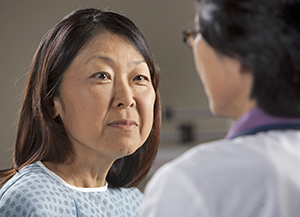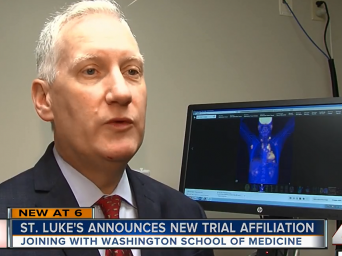Gallbladder Cancer
Symptoms
Gallbladder Cancer: Symptoms
What are the symptoms of gallbladder cancer?
The symptoms of gallbladder cancer often don't start until the tumor is big or the cancer has spread. Common symptoms of gallbladder cancer include:
-
Pain or discomfort in the right side of the upper belly (abdomen)
-
Lumps in the abdomen
-
A sense of fullness after eating even small amounts
-
Nausea and vomiting
-
Poor appetite
-
Loss of weight without trying
-
Fever
-
Yellowing of the skin or the white part of the eyes (jaundice)
-
Severe itching
When to see your healthcare provider
Many of these symptoms are also caused by other health problems. Some are a lot like the symptoms caused by gallstones or gallbladder inflammation. But it's important to see a healthcare provider if you have these symptoms. Only a healthcare provider can tell if you have cancer.
Diagnosis
Gallbladder Cancer: Diagnosis
How is gallbladder cancer diagnosed?
Gallbladder cancer is often diagnosed at an advanced stage because it does not typically cause symptoms early on in the disease when the cancer is small and hasn't spread. When gallbladder disease is suspected, the first test ordered is usually imaging with an ultrasound. A suspicious mass may be seen, but often gallstones are found. In many cases, gallbladder cancer is found by chance when surgery is done to remove the gallbladder to treat a problem like gallstones. This surgery is called a laparoscopic cholecystectomy. A laparoscope is a thin, lighted tube that lets a doctor see your gallbladder and nearby organs. The doctor makes a small cut just above your belly button to insert the tube. Tools are then passed through other cuts in the skin to take out the gallbladder. A pathologist checks the gallbladder when it’s taken out with surgery. A pathologist is a specialist who looks at cells under a microscope to check for problems, such as cancer.
If your doctor thinks you might have gallbladder cancer, you will need exams and tests to be sure. First, your doctor will ask you questions. They will ask you about your health history, your symptoms, risk factors, and family history of disease. Your doctor will also give you a physical exam.
What tests might you need?
You may have one or more of these tests:
Ultrasound
Endoscopic ultrasound (EUS)
CT scan
MRI scan
Cholangiography
Biopsy
Liver function blood tests
Tumor marker blood tests
Imaging tests
Ultrasound. This test uses sound waves and a computer to create images of the inside of the body. The sound waves bounce off parts of the body and send signals to the computer. A computer then receives the signals and creates images.
Endoscopic ultrasound (EUS). This test combines ultrasound with a tool called an endoscope. It’s a long, thin, bendable tube with a light and camera. It’s put in through the mouth or the rectum to reach the small intestine near the gallbladder. EUS creates images of the digestive tract and nearby tissues and organs. A small ultrasound tool is on the end of the endoscope. It lets the doctor see high-quality images of your organs. During EUS, a small piece of tissue can also be taken to check for cancer under a microscope.
CT scan. A CT scanner takes many X-rays as it rotates around you. A computer combines these images to create detailed images. A CT scan can help show a gallbladder tumor or tell if the cancer has spread into the nearby liver. A contrast material may be used to help make the pictures clearer.
MRI scan. An MRI scan uses radio waves and strong magnets to create detailed images of the inside of your body. Your doctor may use an MRI scan to look at organs, blood vessels, and lymph nodes. Contrast may be used.
Cholangiography. These tests are used to see if the bile ducts are blocked or narrowed by a tumor. Some of these tests can also be used to get samples of cells or fluid to look for cancer or to put a stent (small tube) inside a duct to keep it open. The types of this test include:
Magnetic resonance cholangiopancreatography (MRCP). This uses the same type of machine used for MRI scans. It doesn’t need a contrast agent. And it’s not invasive like other types of cholangiograms. This means no tools are put in your body to do this test. A doctor may use MRCP just to get pictures of the bile ducts. But this test can’t be used to get biopsy samples or to put stents in the ducts to keep them open.
Endoscopic retrograde cholangiopancreatography (ERCP). The ducts are reached by passing an endoscope down the throat and into the small intestine. Contrast is put into the ducts, and then X-rays are done. Samples can be taken out through the endoscope to be checked for cancer.
Percutaneous transhepatic cholangiography. The ducts are reached by passing a needle through the skin over the belly and into the liver. Contrast is injected and X-rays are taken to look at the ducts. Samples can be removed, and stents can be placed during this test.
Biopsy
A biopsy is when a small piece of tissue is removed to be checked for cancer. A biopsy can be done during some of the imaging tests listed above. Or a fine needle biopsy may be done. A fine needle biopsy is usually done with the aid of a CT scan to help locate the tumor. This is called a CT scan-guided biopsy. Or an ultrasound can be used to guide the biopsy location. A tiny tissue sample is then taken out through the needle and checked for cancer cells.
Blood tests
No blood test can diagnose gallbladder cancer. Blood test results may be abnormal, but they are not unique to gallbladder cancer, so they aren't the only test used for diagnosis.
Liver function. These are blood tests that help show if the liver is inflamed and how well the liver is working. They can help diagnose liver and bile duct diseases. The gallbladder is part of the liver and bile duct system. Gallbladder cancer can affect liver function, especially the liver tests connected to the blockage of the bile duct system (bilirubin and alkaline phosphatase). The most common liver function tests are:
Albumin and total protein.
Alanine transaminase.
Aspartate transaminase.
Alkaline phosphatase.
Serum bilirubin.
Gamma-glutamyl transferase.
Prothrombin time.
Tumor markers. This is another type of blood test. These tests look for increases in certain substances called tumor markers. Some cancers make these substances. If you have gallbladder cancer, 2 markers may be increased. They are carcinoembryonic antigen (CEA) and carbohydrate antigen 19-9 (CA-19-9). If you are diagnosed with gallbladder cancer, your doctor may repeat this test during your treatment to see how well your treatment is working.
Getting your test results
When your doctor has the results of your tests, they will contact you with the results. Your doctor will talk with you about other tests you may need if gallbladder cancer is found. Make sure you understand the results and what follow-up tests and treatment you need.
Treatment Choices
Gallbladder Cancer: Treatment Choices
There are many treatment choices for gallbladder cancer. Which may work best for you? It depends on a number of factors. These include the location and stage of the cancer. Other things to think about are your age, overall health, the goal of treatment, and what side effects you’ll find acceptable.

Learning about your treatment options
You may have questions and concerns about your treatment options. You may also want to know how you’ll feel and function after treatment, and if you’ll have to change your normal activities.
Your healthcare provider is the best person to answer your questions. They can tell you what your treatment choices are, what outcomes you might expect, and what the risks and side effects are. Your healthcare provider may advise a specific treatment. Or they may offer more than one option, and ask you to make your own decision. It can be hard to make this decision. It's important to take the time and gather all the information you need to make the best choice for you. You may also want to talk with another healthcare provider to get a second opinion about treatment optionschoices.
Types of treatment for gallbladder cancer
These are the most common types of treatment for gallbladder cancer:
-
Local treatments. These remove, destroy, or control cancer cells in one specific area of the body. Surgery and radiation are local treatments.
-
Systemic treatments. These kill control cancer cells throughout the whole body. Chemotherapy is a systemic treatment.
-
Palliative treatments. These treatments help to ease the problems cancer is causing, but they don't treat the cancer itself. This includes things like surgery or stents to open blocked ducts.
You may have just one treatment or a combination of treatments.
Goals of treatment for gallbladder cancer
Each treatment has a different goal. The goal of treatment may be to cure you, control the cancer, or to help ease problems caused by cancer. Your healthcare provider will explain the benefits and side effects of each choice. Discuss any concerns you have before making a decision. The treatments for gallbladder cancer include:
Surgery
The goal of surgery is to take out all or as much of the tumor as possible. The whole gallbladder may need to be removed. This is called a simple cholecystectomy. Nearby tissues may also need to be taken out. This is called an extended or radical cholecystectomy. That may include some of the liver, the bile duct, and lymph nodes. If the whole tumor can’t be removed, surgery may also be done to ease symptoms.
Radiation therapy
Radiation uses targeted X-rays to kill cancer cells in a specific area. This treatment may be used after surgery to try to get rid of any cancer cells that are left in the body. It can also be used to treat cancer that can’t be removed with surgery, or used to help relieve symptoms from advanced cancer. It’s often used along with chemotherapy in these cases.
Chemotherapy
The goal of this treatment is to reduce the chance that the cancer will spread to other parts of your body. It is also used to kill cancer cells that may have already spread beyond the gallbladder. Chemotherapy is usually given along with surgery or radiation. Low doses of chemotherapy may be given with radiation. This can help the radiation work better. Chemotherapy may be given by itself if the cancer has spread from the gallbladder and can’t be fully removed with surgery.
Asking about clinical trials
New ways to treat gallbladder cancer are being tested in clinical trials. Before starting treatment, ask your healthcare provider if there are any clinical trials you may want to consider.
Providers

Timothy J Pluard, MD


